Winter Heating
(Destratification or Destrat Fans)
Thermal Stratification is the single biggest waste of energy in buildings today.
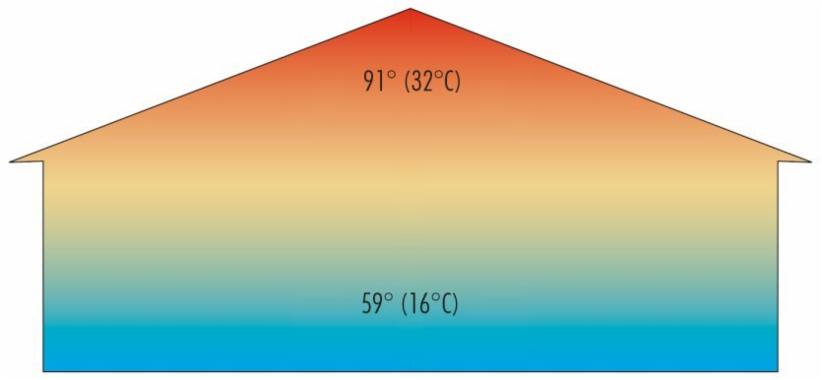
What is ‘Thermal Stratification’ ?
Every building will experience some degree of thermal stratification, a natural process that causes warm air rises to the ceiling or roof space and displaces cooler air, pushing it downwards into the occupied space. In most workspaces, irrespective of the height of the ceiling, the occupied space where people need to be kept warm is up to around 2m from the floor. Any energy used to heat the air above this point is therefore generally wasteful.
Typically, the temperature rise is 0.8-1.6°C per metre of height. This means in a 10M high building, to achieve 16°C at the floor, the roof area temperature is likely to be 32°C.
This is a clear indication of significant energy wastage, as much of the energy consumed by the heating plant is being used to heat unoccupied areas of the building – namely the roof space!
Increased Fabric Heat Losses
The higher temperature air in the roof space also has implications for how quickly the building loses heat. For example, the set-point temperature for the working zone may be 19°C. On a cold day with an outdoor temperature of -1°C this would provide a temperature difference between the working zone and the outside of 20°C. However, as noted above, the air in the roof space will be at a temperature of around 32°C, creating a temperature difference between the roof space and the outside air of 33°C. This is significant because the rate of heat loss is influenced by the temperature gradient. This means that the higher temperature difference between the air in the roof space and the outside air will increase the rate of heat loss through the roof membrane. Reducing the temperature of the air in the roof space will reduce the rate of heat loss through the roof membrane.
Infiltration Losses
Another issue to consider is the effect of temperature gradients on the natural rate of ventilation, whereby air enters and leaves the building through leakage points in the building fabric. It is well established that some of the warm buoyant air rising into the roof space will leave the building through high-level leakage points. This will create a small negative pressure that will have the effect of drawing more cold outside air into the building through lower level leakage points. This cold air entering the building at low level therefore reduces the temperature in the working zone so that the heating system needs to consume more energy to restore the required set-point temperature. Fabric heat losses and air infiltration are particularly significant issues in older buildings that have poor thermal insulation and many leakage points.
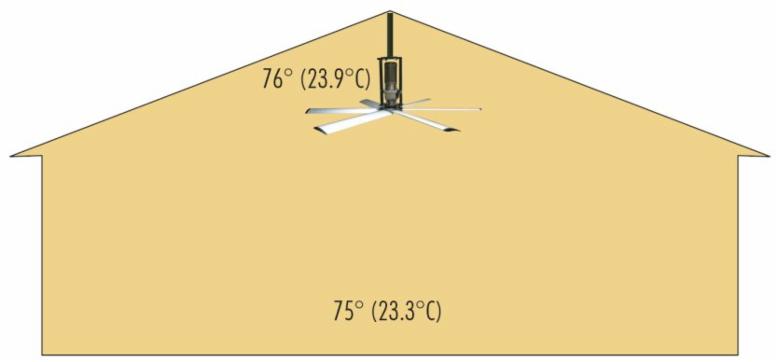
In a destratified building temperature differentials can be reduced to 1 – 2°C or less from floor to ceiling
The Benefits Of Destratification Heating
A well-designed destratification system addresses all of these issues by ensuring effective distribution of heat throughout the space so that stratification is minimised and there is only a very small temperature gradient between the working zone and the roof space. The ability of the HVLS destratification fan system to reduce the temperature of the air in the roof space also reduces the rate of heat loss through the roof. For example, if the roof space temperature were reduced from 32°C to 23.9°C this would result in around a 25% reduction in the heat loss through the roof membrane. In many cases improving the distribution of warm air with HVLS destratification fans will make it possible to maintain the required temperature in the working zone with fewer warm air heaters, thereby reducing both capital and running costs. In industrial buildings, the HVLS destratification fans will also recirculate the heat from machinery, so that less energy is consumed by the heating system.
Furthermore, improved air distribution helps to eliminate hot and cold spots in the working zone to improve comfort levels. HVLS Destratification fans can also be used to provide cooling flow of air during the summer simply by increasing the fan speed.
See our HVLS Destratification fans in action here
So….how much will you save by installing HVLS fans ?
Following a detailed study by the school of aerodynamics at Liverpool University on HVLS fan technology, we have INDEPENDENTLY verified data providing typical energy savings.
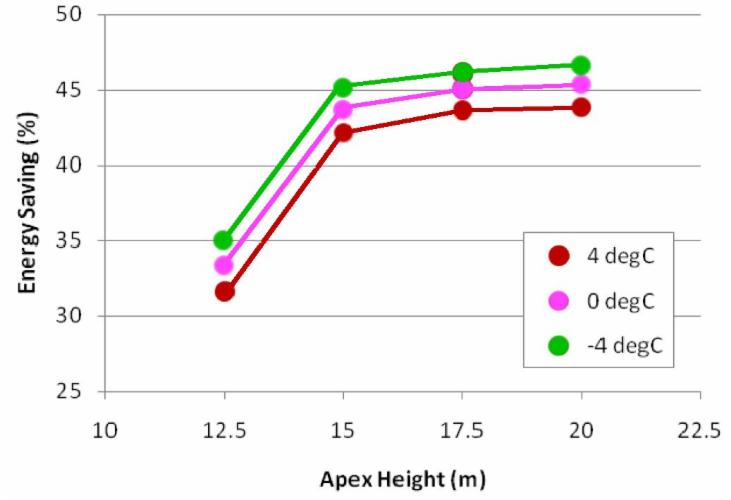
The amount of heating energy saved by using HVLS fans increases with increased building height and decreasing outside air temperature.
The graph above shows this relationship. The red line indicates % energy savings with outside temperature at 4°C (Average UK winter air temperature).
The graph shows 12M high building will typically save 32% of heating energy, where a 15M high building will typically save 42%, increasing to 43% at 17.5M and 44% at a building height of 20M.
However, as the outside air temperature decreases, the savings increase, meaning a 20M high building with an outside air temperature of -4°C will save 47% in heating energy consumption.
How do we achieve such HUGE energy savings ?
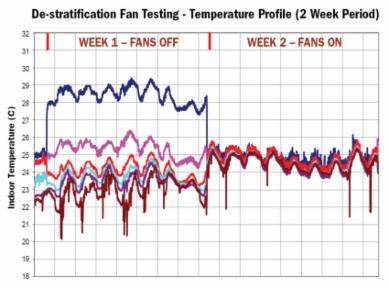
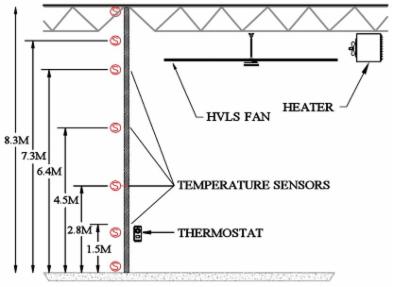
The stratified air layers can clearly be seen in between the two.
With HVLS fans running in week 2, there is no longer any stratification and all sensors are essentially recording the same temperature. As the destratified floor temperature was several degrees higher than the stratified floor temperature, the thermostat setting can be lowered, reducing the heating system run time and saving heating energy.
